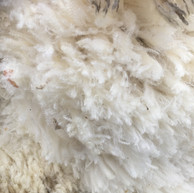Finding the value in the Fleece
- Jessica Steer - The Rushlade Wool Company
- Feb 16, 2019
- 2 min read
We are in our third year as ‘The Rushlade Wool Company’. We already had generations of sheep farming behind us but it was in January 2017 that we started to look at the value that the wool offered and the opportunities to diversify and add value to our business.
Much of our flock is what we term our ‘Commercial Flock’, being those that are there for the breeding and place in the production of meat. On the other end of the spectrum we have the Merinos (Bowmont Merinos) that offer no meat value and are solely here as our ‘Wool Flock’. They are by far the most expensive sheep we have to keep not only because they have more limited opportunity to earn us money: Wool and the sale of progeny, but also because they are a more demanding breed requiring more housing and feeding than any other stock. Next on we have a breed like the Teeswaters. The Teeswater sits in both camps as it has a value as a good marketable value as a breeder, a commercial sheep and also has amazing wool. It’s relatively sensitive and benefits from some extra tlc. The wool is gorgeous and demands a relatively strong price but it needs to be in order to balance out the extra care needed to achieve the quality of fibre. They’re also the sires of the Masham, another great wool producer but also a decent commercial sheep. This meaning that not only do they give a great product for the wool business but are worth keeping for farming too.
The Whiteface Dartmoor mule is a favourite here. It’s mother is a Whiteface Dartmoor and our local rare breed. A beautiful and hardy breed, these girls are great mothers and produce excellent mule lambs when crossed with a Bluefaced Leicester. The resulting mule has a fabulous fibre - curly locks with the lustre of its Blueface Leicester father. It’s a relatively cheap fibre to buy because it’s unknown and not as soft or fine as something like a Teeswater (But is still amazing!). Again, it’s also a good commercial sheep so we can afford to sell the wool cheaper as they have other value to us too. The pattern therefore being that the value of the fleece comes from the quality of the fibre but this must also relate to what other value the animal provides and the cost to keep her. A bit of market research (Facebook trawling mainly!) will give you a good idea of the value of a fleece and is helpful when looking at a new breed for example. It is also important to remember that just because someone is marketing something at a price, that doesn’t make it the value. The value is only established by a willing buyer and a willing seller and the price they are prepared to exchange at, at a given time (Cue the chartered surveyor in me!). We are always happy to discuss fleece, send samples and work with spinners, knitters, felters etc. to produce the fibre that you want, at a price that works for both parties to achieve a sustainable future for our industry and your crafts!

























Comments